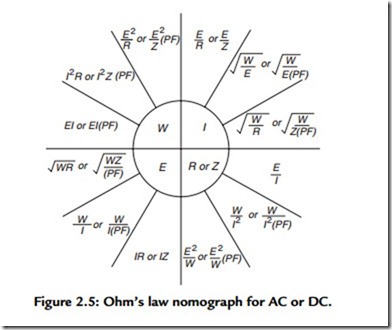Directivity Factor
Finally, make the point source radiating one acoustic watt a hemispherical radiator instead of an omnidirectional one. Thus at 0.282 m the surface area is now half of what our sphere had or 0.5 m2. Therefore our intensity is now 1 W/0.5 m2 or the equivalent 2 W/m2:
Therefore our LP is 123.01 dB. Lw remains 120 dB.This 3.01-dB change represents a 2:1 change in the power per unit area; thus, a hemispherical radiator is said to have twice the directivity factor a spherical radiator has. The directivity factor is identified by a number of symbols—DF , Q, Rθ, λ, M, etc. Q is the most widely used in the United States so we have chosen it for this text. Directivity can also be expressed as a solid angle in steradians or sr = 4π/Q.
Ohm’s Law
Recall that the use of the term “decibel” always implies a power ratio. Power itself is rarely measured as such. The most common quantity measured is voltage. If in measuring the voltage of a sine wave signal (oscillators are the most reliable and common of the test-signal sources) you obtain the rms voltage, you can calculate the average power developed by using Ohm’s law. Figure 2.5 is a reminder of its many basic forms and uses the following definitions:
W is the average electrical power in watts (W). I is the rms electrical current in amperes (A). R is the electrical resistance in ohms (Ω).
E is the electromotive force in rms volts (V).
PF is the power factor (cos θ).

